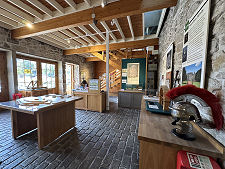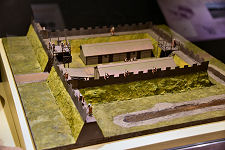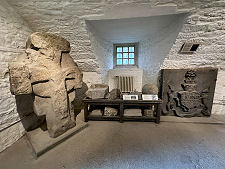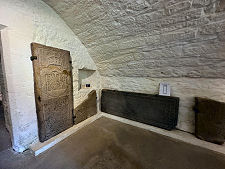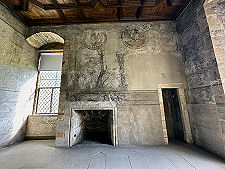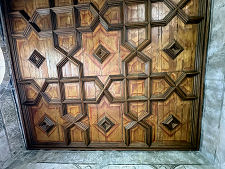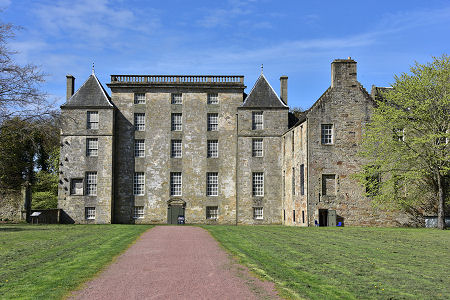 Kinneil House from the East |
The Kinneil Estate lies immediately to the south-west of Bo'ness, above the ridge that climbs steeply from the narrow plain along the shore of the River Forth. It is signposted from the A993, but is easy to overlook. The visitor approaches along the drive leading to the imposing east front of the house and just before the large free-standing gateposts finds a junction. Turning left takes you to a parking area accessing the main parts of the estate, but first time visitors will probably want to turn right, to park in the area in front of the small museum.
What the museum at Kinneil lacks in size it more than makes up for in design and content. It is well worth a visit to gain an initial impression of what there is to see on the estate, plus an overview of what begins to feel like a very complicated history with a bewildering number of different components.
The Kinneil Estate is the nearest you are likely to find to a history theme park anywhere in Scotland: made all the more impressive because it covers two thousand years; because everything you see is real; and because it is displayed in such a low-key and matter-of-fact way. You can quite literally stumble over history at Kinneil.
The most obvious component of this is Kinneil House itself. After visiting the museum you should make your way around to the front of the house. In 1323 lands hereabout were granted by Robert I to Walter Fitzgilbert of Hamildon, the head of the family which later produced the Dukes of Hamilton. The Hamiltons maintained their main seat in west central Scotland, but over the centuries Kinneil became their base in the east. In the 1400s they built a small tower house here in an easily defensible position overlooking a deep ravine. (Continues below images...)
 Another View of the house from the East |
 The Highly Decorated Arbour Room at Kinneil House |
In the late 1400s or early 1500s the small tower house was enlarged into a very much larger tower house. As the 1500s progressed the need for defence became less important than the need for comfort, and in 1553 James Hamilton, 2nd Earl of Arran built a palace a little way from the tower house to its north-east. Then, in 1667, William, Duke of Hamilton and Duchess Anne launched a major expansion of Kinneil House that saw the tower house and palace joined together by means of one of the two decorative towers they built, flanking the original tower house. Within a century, however, the Hamiltons had ceased to use Kinneil, and rented it out to tenants. At various times these included John Roebuck, owner of the Carron Iron Works, and the philosopher Dugald Stewart, who wrote a number of his works while living here.
In 1922, Bo'ness Town Council purchased the estate. In 1936 work began on the demolition of Kinneil House. The tower house was totally gutted, but when work began to strip out the interior of the palace it was discovered that it contained the most extensive and best preserved wall and ceiling paintings in Scotland.
Demolition work was thankfully halted, and today the palace is open to the public for guided tours at weekends. A visit to the house is well worthwhile, with interesting displays on three floors linked by spiral staircase: but the main glory of Kinneil House is the painted decoration of the walls and ceilings of the first floor Arbour Room and Parable Room, which date back to several different stages between 1550 and 1625. The upper floor is given over to information displays and samples of decorated wood, stone and plaster salvaged from elsewhere in the house in 1936; while the lower floor is home to a recreated kitchen and a display of rare grave slabs recovered from Kinneil Church (see below) and stonework that adorned the exterior of the house until 1936.
Having viewed Kinneil House, you should walk through the gateway in the side wall at its southern end. From here you can wander round the rear of the house, or cross a bridge over a stream that leads to open parkland beyond. First, however, take a look at the roofless remains of a small cottage close to the south-west corner of the house, complete with a nearby large metal cylinder. In 1769 and 1770, when John Roebuck was the tenant at Kinneil, he employed James Watt to undertake experiments to develop a more efficient steam engine capable of pumping water out of deep coal mines under the River Forth.
Watt succeeded in his quest, though only after he had left Kinneil. The experiments were kept secret by housing them in this cottage close to Kinneil House itself. Whether it was entirely wise to employ someone to develop a bigger and better steam engine only yards from where you are living is open to debate: though perhaps the fact that the old tower house has walls that are six feet thick gave Roebuck a greater sense of security!
After crossing the bridge over the stream you emerge into a broad swathe of parkland. This was once traversed by the Antonine Wall, which for 20 years was the northern boundary of the Roman Empire: but it takes a little imagination to be able to see traces of the line of the wall today. What you do find, however, on the edge of woodland off to the right of the parkland, are the scant remains of Kinneil Church. The church was originally built in the 1100s, and by the 1400s was the focus of the village of Kinneil, which occupied much of the parkland to the south of the church. The main street through the village even reused the stone base of the (otherwise turf) Antonine Wall.
During major redevelopment of Kinneil House in 1667, the village was cleared to allow a park to be established, the villagers mostly relocating to the rapidly growing town of Bo'ness a short distance away. Today, all that remains of the village and the villagers are the grave slabs around the ruin of the church (and others kept in the vault of the palace). The church itself continued to be used as a chapel by the Hamiltons until 1745, when it was accidentally burned down by troops based in it to guard Kinneil House during the Jacobite Uprising.
From the church, you should continue west for several hundred yards. Here you find that, although nothing remains of this part of the Antonine Wall, there are still traces of one of the forts that helped guard it. These are visible on the ground as humps and bumps, and original post holes have been used to place posts showing the shape of some of the elements of the fort. Meantime, the main roadway entering the fort from the north is visible on the ground following excavation.
Two thousand years of Scottish history in one short walk. A Roman fort; remains of a medieval village and church; a castle that became a grand house; a small but important fragment of the industrial revolution; and an attractive and informative museum pulling it all together. Plus woodland walks and pony trails if you want something more than mere history!
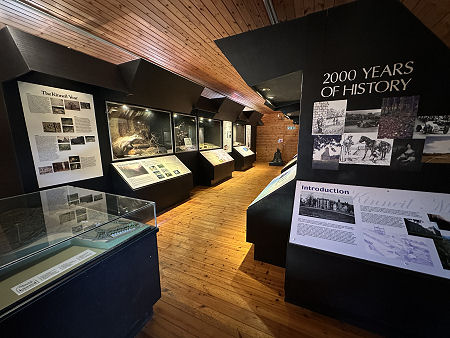 Inside the Museum |

|
|
|
Visitor InformationView Location on MapGrid Ref: NS 983 806 kinneil.org.uk What3Words Location: ///beeline.cities.scribble |
 North Side of Kinneil House |
 South Side of Kinneil House |
 The Palace |
 The Main Door to the Tower House |
 Interior of the Tower House |
 The House from the South-West |
 The Front of Kinneil House |
 The Rear of Kinneil House |
 Watt's Cottage |
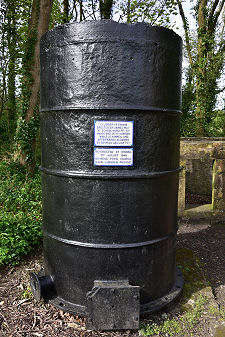 Engine Cylinder |
 Kinneil Church |
 Graves at Kinneil Church: all that remains of Kinneil Village |

